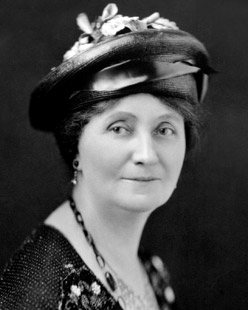Mary Ellen Smith
First woman elected to the Legislative Assembly (1918) and first woman in the British Empire to be appointed a cabinet minister – without portfolio (1921)
 Image B-01563 courtesy of the Royal
Image B-01563 courtesy of the Royal
BC Museum and Archives Mary Ellen Smith was born in England in 1861. She trained as a school teacher before immigrating to Canada with her husband, Ralph Smith. They settled in British Columbia, where Smith played an important role in her husband's election to the Legislative Assembly in 1898, and later to the Canadian House of Commons.
A provincial referendum on women's suffrage was held in 1916. The results revealed that 65 percent of the men who voted were in favour of extending the franchise to women. In 1917, the
Provincial Elections Act was amended to grant women who qualified as British subjects the right to vote in provincial elections and to stand for election to political office.
Smith had been a passionate activist for women's suffrage in the decades leading up to the successful 1916 referendum, and following her husband's sudden death, she stood as an Independent candidate in the 1918 by-election for his vacant Vancouver City seat. Running under the slogan "women and children first", Smith was elected as an Independent Liberal with 58 per cent of the vote, becoming the first woman elected to the Legislative Assembly.
While the newspapers debated whether a woman should be allowed to wear a hat in the Legislative Chamber, Smith immersed herself in her new role. True to her campaign promise, she advocated on behalf of women, children and the underprivileged, introducing a bill to establish a minimum wage for women and girls, and supporting measures to create juvenile courts and allow women to sit as judges. Smith was re-elected in 1920 and 1924 under the banner of the Liberal Party of the day.
In 1921, she achieved another significant milestone, becoming the first woman in both Canada and the British Empire to be appointed a cabinet minister – without portfolio. Smith served in the Legislative Assembly until 1928. Upon retirement from public office, she became President of the B.C. Liberal Party, a position she held until her death in 1933.